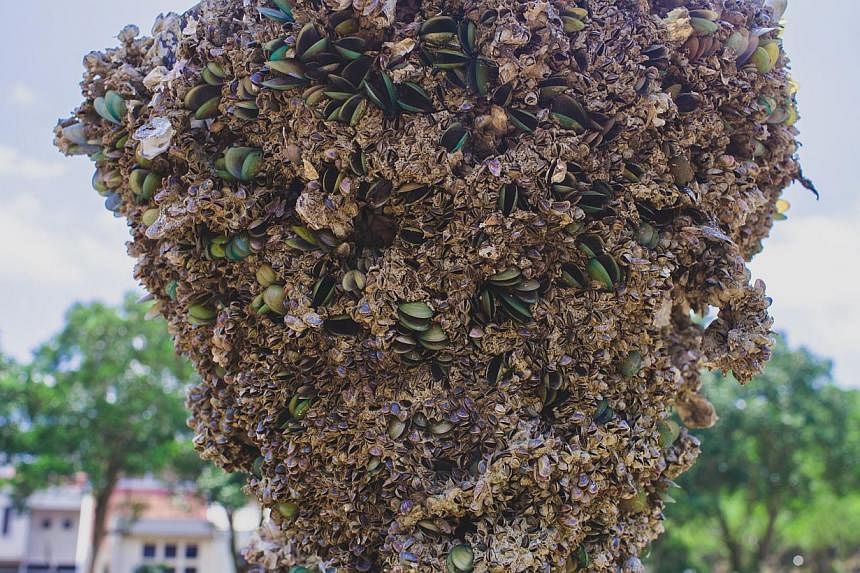Buoy oh buoy - the massive maritime-themed installation at the Singapore Pavilion of the Venice Biennale was a challenge from start to finish for creator Charles Lim.
The award-winning film-maker, artist and former national sailor channelled a lifelong fascination with the sea into Sea State, which looks at the impact of reclamation and expansion works in Singapore. Curated by Shabbir Hussain Mustafa and on display in Venice until Nov 22, the work includes maps, charts and video installations grouped around a 5m-tall aluminium buoy encrusted with barnacles.
The idea is to show how the seas around Singapore have changed over the years, with islands absorbed into the mainland via reclamation works.
So Lim, 42, chose as his centrepiece a navigational marker similar to that which once marked an island off the coast of Singapore, Pulau Sajahat. It disappeared from maps in 2002, thanks to reclamation.
Getting the company which created the original buoy to make a replica was relatively easy compared with the task of turning the shiny new buoy into something approximating the barnacle- encrusted original.
"We wanted to submerge it for a year but it's illegal to submerge a buoy," Lim says. Eventually, he found a sponsor willing to let him keep the buoy in offshore waters for four weeks.
Then came the challenges of transporting the buoy while ensuring that the barnacles and sea-life encrustations did not drop off in transit.
When the buoy finally reached Venice's historic military shipyard, the Arsenale, one of two main locations for the ongoing Biennale, it was discovered that it was too big to fit through the 16th-century windows on the 250 sq m first-floor space that Singapore has signed a 20-year lease on.
Luckily, Turkey, which has the space next door, allowed the Singapore contingent to use its staircase and corridor to bring in the buoy.
The story of the buoy gives only a slight indication of the mammoth work that is Sea State, a culmination of more than 10 years of Lim observing, filming and recording Singapore's relationship with water, reclaimed land and history.
Part of the inspiration was the artist's own story: He grew up in the Mata Ikan kampung which no longer exists in Simei, and his paternal grandmother searched the shore for seashells which were then ground to make acidic limewater for painting house walls.
He remembers seeing her scars from the work, while his father, a self-taught sailor who later had his own pest control business, explored the sea on a homemade bamboo raft as a boy.
"Actually, I hated sailing at first," laughs Lim, who represented Singapore in sailing at the 1996 Olympics. "My father bought a boat and raced it on weekends so I began to associate sailing with him."
Lim was educated in boarding school in England, returned to Singapore for national service and then studied in London at the Chelsea College of Art and Design before completing his bachelor's of fine arts from Central Saint Martins School of Art and Design.
He began experimenting with film, thanks to his wife, arthouse film director Wee Li Lin, who also acts as his manager and producer.
Various iterations of the Sea State project have been exhibited at Manifesta 7, the 2008 European Biennial of Contemporary Art in Trentino, Italy; the Shanghai Biennale in 2008; and at the 2011 Singapore Biennale.
In the 2008 short film titled "it's not that i forgot, but rather i chose not to mention", a man swims laps across a leaf-choked abandoned swimming pool in Singapore.
Three years later, a surreal excursion through the drains and canals of Singapore, All The Lines Flow Out, received a special mention at the 2011 Venice Film Festival as well two awards in 2012 - best experimental short at the Nashville Film Festival and a Silver Award at the 17th Hong Kong Independent Film and Video Awards.
Lim's working relationship with curator Mustafa began with In Search Of Raffles Light, an archival project and exhibition about the Raffles Lighthouse on Pulau Satumu, one of several islands south of Singapore. It was exhibited at the National University of Singapore Museum in 2013.
Forgotten histories, including the disappearance of Pulau Sajahat as well as the relocation of Singaporeans from the offshore islands, are shown through maps and topographical installations at Sea Stage at the Venice Biennale.
Equally memorable is another surreal journey above and below the seascape of Singapore through two linked video installations.
One titled Capsize shows Lim riding the waves and when his vessel apparently sinks beneath the waves, the eye is drawn to the opposing screen. Here, in the film titled Phase 1, workers carry an Optimist sailboat through the Jurong Rock Caverns, the 130m-deep, 61ha area excavated below Jurong Island and used for chemical storage.
"These are new ways of looking at the sea. You have saltwater raining down but you don't get the feeling of being under the sea," says Lim, who originally planned to have someone else film this part of the project. He had to take it on when the cameraman hired refused to go in.
"This is how I think we as Singaporeans feel sometimes, very unstable on reclaimed land."


